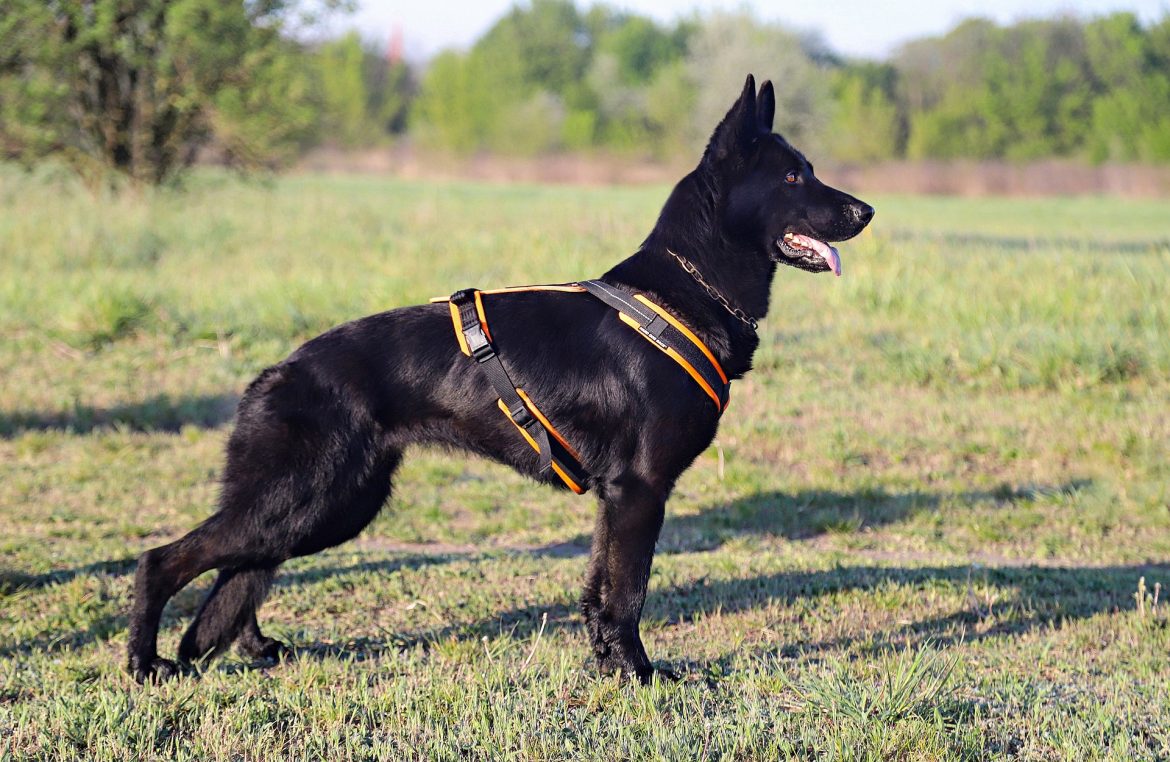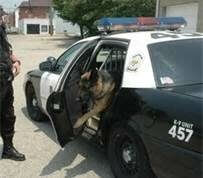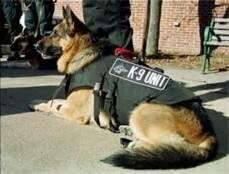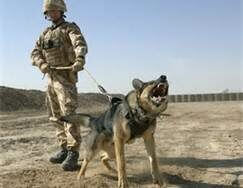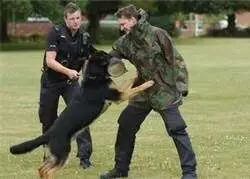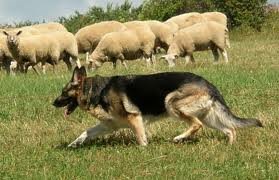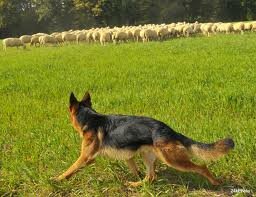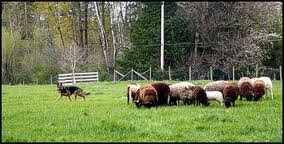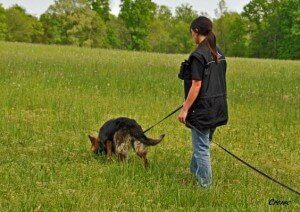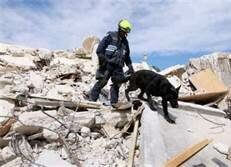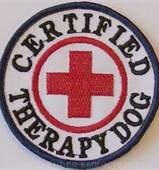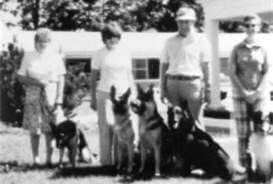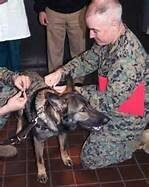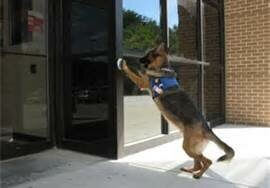Table of Contents
In the canine world, a German Shepherd is a large breed of dog with an extraordinary intelligence level. This breed hails from Germany, and it is just over one century old, which makes it a relatively new strain. They make awesome family pets, as well as skillful working dogs. Let’s find out the main jobs for a German Shepherd Dog.
German Shepherd as Police Dogs (K-9s)
Police dogs that work within the realms of LE, are called K-9, which is short for the canine. K-9 or police dogs units exist in almost every community in the United States. They commonly work with officers at the county, state, and federal levels. In addition, German shepherds are employed by the Federal Bureau of Alcohol, Tobacco, Firearms, and Explosives (ATF.)
First, let’s look at the basic characteristics of the German shepherd and at the reasons why they make such marvelous police dogs. It takes more than just their intelligence and good looks to get them hired for the job. Traits that set them apart from the other breeds include a natural curiosity, athletic ability, and the desire to perform a job. Total obedience is also required of these amazing animals, under any circumstance and environment. This is why there are more German shepherd police dogs than any other breed.
Characteristics Of German Shepherd Police Dogs
Its sense of curiosity helps to keep this clever shepherd focused during search and rescue missions, and its keen sense of smell aids it in finding drugs and explosives. In larger cities, a K-9 team has many more police dogs so each one can specialize in a single area such as weapon detection. However, smaller towns that only have a single K9 dog or police dog make it necessary for that one to receive training in all areas of police assistance. This includes sidewalk patrolling, suspect apprehension, and corpse finding missions. All areas of the USA would benefit from the use of police dogs.
German shepherds are quick at learning hand signals by sight, and they eagerly obey commands given by their owner or trainer. When in training, their desire to learn is evident, and it soon turns to pride and self-assuredness as they go through their routines. However, real-life action brings into play the animal’s intellect, as it sometimes must decide on which skills to use if it is separated from its handler. This makes for excellent police dogs.
Additionally, German shepherds as police dogs are highly protective of their owners and territory, which makes them perfect partners for LE officers. Police dogs who ride alongside officers in a patrol car are very protective of the vehicle and the officer’s equipment. The job of a guard dog is also a good one for this type of dog as long as there are enough mental stimuli to keep it from becoming bored.
What Makes Good Police Dogs or k9′s ?
Physically, the German shepherd is dignified and a beautiful dog to behold. Their stand-up ears add an alert look to their chiseled face, which features a long snout. One way to recognize a full-blooded German shepherd is by the bump on the upper part of their nose near the bridge. Their coloring is tan or red with a black saddle and mask, brindle, black or white. Additionally, their strength is apparent in their build, which is lean and muscular if they are active. These hardy dogs have a double coat of hair that causes them to shed quite a bit.
Although German shepherds have many good qualities, these are the most pronounced:
- Handsome and powerfully built
- Intelligent and eager-to-please
- Devoted and dependable
- Strong-willed and courageous
- Obedient and protective
- Handy and agile
- Hard-working
Training Police Dogs for Work
First, only dogs that have proven good temperaments are entered into training programs to become K-9 police dogs. Any German shepherd that displays signs of over-aggressiveness or an inability to focus and engage in their exercises is not right for this job of becoming a police dog. Moreover, a good candidate for becoming a K-9 or police dog must be 100 percent predictable and reliable because their future partner’s life can depend on it.
Before they begin training for police work, German shepherds must first master advanced obedience training. Next, they must pass agility training on an obstacle course and learn to track by scent and by sight. Once the dog masters all of those skills, it is time to learn the art of protection and apprehension. This is where a special trainer begins bite-work training with the dog, using a padded bite-sleeve. The German shepherd is taught how to knock down a perpetrator and keep them there by biting down on the person’s arm. This is called the bite-and-hold command.
Programs Dedicated To Helping Working Police Dogs
Like any human police officer, a police dog works with the threat of getting shot or receiving another injury as part of its job. It is important for K-9 dogs to wear bullet-repelling safety vests, but some police departments are unable to find funds for them. Donations from the public are welcomed and appreciated.
Additionally, emergency and routine care need to come up. Police dogs need vaccinations, flea and tick treatment, and regular exams. Thanks to the wonderful veterinarians and vet technical assistants who work for reduced rates or give their services free of charge, many K-9 dogs recover from injuries and continue to work at safeguarding the public.
Furthermore, police dogs must stay in shape with regular exercise just like any other athlete. Accidents are more likely to happen to a dog that does not receive ongoing training, exercise, and warm-ups. The National Police Dog Foundation (NPDF) helps K-9 handlers by being their ally and advocate for medical concerns like snakebite, all types of wounds, and accidental drug ingestion, among other hazards. The NPDF can also assist an officer in finding the closest veterinarian who provides free or greatly reduced fees for medical emergencies.
German shepherd K-9s or police dogs are considered officers of their department, equal to their human counterparts. They are given badges and treated to the same funeral processions as are all police officers. K-9 police work is a noble cause that seems fitting for such a noble breed of dog.
German Shepherd as Herding Dogs
German Shepherds originated from the German herding varieties used by local German shepherds for guarding and herding dogs of sheep. There was a focused attempt to standardize the breed in Europe during the 1800s. In local communities throughout Germany, shepherds bred dogs that displayed the necessary traits for sheep herdings, such as strength, intelligence, loyalty, and speed. There are of course several breeds suitable for developing herding dogs such as the Border Collie and Australian shepherd among others. Herding dogs were all adept at the herding of sheep, but they varied greatly in ability and appearance.
Brief History of the German Shepherd
Max von Stephanitz is credited with standardizing the German Shepherd breed. Von Stephanitz ran across a dog named Hektor at a dog show in 1899. Hektor displayed all of the attributes von Stephanitz believed herding dogs should have. Taken aback by Hector’s beauty, strength, intelligence, and loyalty, he purchased Hektor on the spot and changed his name to Horand von Grafrath. Horand became the first registered German shepherd and went on to sire hundreds of pups.
German shepherd herding dogs have been specifically bred for obedience in order to view and help the shepherd as pack leader. Thus, they have a strong pack pride, and if training methods are used that do not consider this inherent drive, the German shepherd will not be capable of working independently, whether it’s herding dogs or any other kind of working dog. Thus, proper training is essential in establishing strong herding dogs, regardless of their breeding.
Shepherds use German shepherd herding dogs to contain and control large flocks of sheep or groups of livestock like cattle. These animals must be contained in specific grazing areas and kept from neighboring crops. German shepherds use boundary control and flock containment in order to keep a shepherd’s flock from damaging crops among the many jobs of herding dogs.
Selecting the Best German Shepherd for Herding
When training German Shepherds for herding dogs, it is necessary to spend as much time with it as possible from the day it is born. This allows the pups to become familiar with the tones of your voice, which is crucial. The following tests should begin being performed when the pups are around three weeks old in order to determine which ones can become competent herding dogs:
Start out by putting a pan of food in with the litter. When the puppies place their full attention on the food, go somewhere where they cannot see you and make a loud noise. Do this multiple times and take note of the ones that pay no attention to the noise.
Training the Young German Shepherd
When the pups are 4-6 weeks old, see which puppies come to you when you call them. Take note of the ones that show the greatest interest and attraction to you.
Also during this period, put a lamb, or any other livestock they will be herding, in with the litter every other day. You want to start with a young lamb or other animal and increase the size as the puppies grow. Repeat the process every other day for three weeks and see which puppies show and maintain a keen interest in the animal. These have the best potential as herding dogs.
After the potential herding dogs are seven weeks old, put an appropriate sized lamb or calf in with the litter and notice which puppies grip the animal in the top of the neck, above the hock, and the ribs, as these, are the three places allowed for gripping. Any puppies that grip the animals, not in these three places should be eliminated as potential herding dogs.
More Puppy Testing for Herding Potential
Also during this seven-week period, constantly watch the potential herding dogs puppies and see how each one reacts to your presence and responds to the tones of your voice. This will be important when training the chosen dogs in the field as potential herding dogs.
Methods of Testing Puppies
This allows you to accurately select German Shepherds with a strong drive for natural prey that is essential for self-confidence, acceptance of the shepherd as the leader of the pack, and sheep herding. Only select puppies for potential herding dogs that fully meet this criterion. However, even if a puppy does not seem to meet the criteria within this time frame, there is still hope, because a dog’s character and potential for work are not fully developed until it is three years old.
These testing standards are extremely high and more than likely not suitable for a hobbyist. A working shepherd must be much more demanding of his dogs than someone pursuing shepherding as a hobby. A working shepherd must have a dog that will maintain its concentration all day long, day in and day out. This level of intense concentration can only be achieved by a German shepherd with the highest degree of natural instinct and attraction to sheep or livestock and make excellent herding dogs.
Cornerstone Training for Herding Dogs
The cornerstone of training for a German shepherd herding dog is the dog’s acceptance of the shepherd as the leader of the pack and its understanding of voice commands. This is the reason why it is necessary to expose puppies to the subtleties and variations of your voice from birth, both the pleasing voice and the sharp, displeased voice. Similar to how puppies learn from their mother’s tone of voice, your voice must be recognized as the means of correction and praise when training potential shepherd herding dogs.
There should be no reason for physical correction if you establish confidence and trust as the pack leader from the beginning, and the German shepherd herding dog has been properly conditioned to understand the meaning behind the tones of your voice.
Important Traits in Herding Dogs in Early Training
During early training in the field, the German shepherd should be restricted on a leash, but the leash should only be used to guide the dog, not punish it. The German shepherd should only be taken off of the leash when it has begun to view the sheep or livestock as subservient members of the pack. The dog must feel it necessary to defend the flock and keep it in order. This comes with the dog’s understanding of boundaries and putting sheep that stray outside the boundaries back in place.
Potential in Herding Dogs
When training potential herding dogs such as the shepherd dog, there is no place for punishment or forced training. This only weakens or completely destroys a dog’s self-confidence and its willingness to trust and follow its own instincts, which ultimately affects the ability of the dog to work on its own. These are qualities that every shepherd dog must possess. This goes back to testing a dog’s instincts. If a dog wants to help a shepherd and has the instinct and attraction to the sheep, then the dog’s natural instincts only need to be harnessed and directed. Force training only suppresses these natural qualities in potential herding dogs.
During a German shepherd’s first year, obedience work should consist of establishing voice communication and play training. Early on, the aim of play training should be to build the dog’s confidence and establish a trusting and respectful bond between the shepherd and the dog. The dog should be praised when it does something right, but it should never be punished for doing the wrong thing. This is because all dogs have a desire to please the pack leader, and they will correct themselves in order to gain praise. Therefore, only voice corrections should be made, and you should always give the German shepherd the opportunity to correct itself. After the dog is one year of age, then serious training can begin, but only after the dog displays that it is ready.
Do not Confuse Sheep Herding for Obedience Training
Herding training should not be construed as obedience training. Rather, it is the symbiotic relationship between shepherds and their herding dogs. The German shepherd should be encouraged to work according to its own instincts more than the commands of the shepherd. The stronger a dog’s instincts, the better suited the German shepherd will be for working with sheep and livestock, and the less it will need to rely upon commands and become one of the many great herding dogs.
German Shepherd as Search and Rescue Dogs (SAR)
Search and rescue (SAR) dogs are used primarily to locate missing persons such as lost or missing children, lost hikers, avalanche victims, people trapped under debris during some sort of disaster, and even suspects in criminal investigations. SAR dogs locate numerous missing persons every year.https://www.youtube.com/embed/yxhpz5Zi2Mw?feature=oembed
Traits of a Search and Rescue dogs SAR
The German Shepherd Dog is well suited to perform the tasks required of a good SAR dog. The typical SAR dog or search and rescue dogs are highly intelligent, making the dog perfect for obedience work. A SAR dog must have a strong play drive, which means they are very focused on chasing and recovering play toys. They are anxious to please their owner and have an intense ability to focus on tasks. Another characteristic required of a SAR dog is that the dog is non-aggressive, especially with other dogs and with strangers. Finally, the dog must show strong ability in at least one of these areas: tracking or trailing, air scenting, human remains detection, and/or disaster recovery.
Tracking vs. Trailing
Each person gives off an individual scent that can be detected by a trained canine.
Tracking dogs are trained to specifically follow the path a missing person took by keeping their head to the ground to follow the scent left behind by the missing person. This type of SAR dog must remain focused on the specific path taken by the individual.
Trailing dogs are trained to follow the scent of the person but they do not keep their heads to the ground; they often deviate from the exact path the missing person took because they are also using air scenting techniques. Both of these dogs must be started from a location where the missing person was last seen and often are given a scent article to follow.
Air Scenting
Air scenting dogs are able to follow the scent of a person by using air currents. They do not have to begin at the location where the person was last seen: Instead, they can work from the general area where the person is believed to be located and follow the scent back to the person’s location. Human beings shed thousands of skin cells each minute. Air scenting dogs can actually detect the skin cells that are carried on air currents in order to track back to where the missing person is located.
Cadaver Dogs
Deceased human beings give off an individual scent that can be tracked by a SAR dog. Cadaver dogs are also trained to detect the gases given off by a corpse. Some dogs can even detect the scent of human remains that are underwater.
Disaster Recovery
Disaster recovery dogs are trained to handle the chaos of a natural or man-made disaster scene. They must work in perilous conditions and on a variety of terrain. Disaster recovery dogs are essential to locate people trapped under collapsed buildings or in debris. These dogs are not searching for a particular human being, but are following clues and scents to locate anyone trapped under the debris.
SAR Dogs Training
A typical SAR dog requires at least 600 hours of training. The SAR dog must go through basic obedience training, and then go through the advanced training required for the SAR dog. One of the first things the handler must do is figure out which reward works best for that particular dog. For example, if the dog loves to play tug-of-war, the handler can use this play as a reward.
How Play Reward Works
In training a dog to air scent, the initial work is done with the handler and an assistant. The assistant restrains the dog while the handler hides somewhere nearby, often within sight of the dog. When the dog is released and ordered to ‘find it’, the dog will instinctively run to the handler. The handler then rewards the dog with a boisterous game of tug-of-war. The dog is then returned to the assistant while the handler hides again. This is done over and over again while gradually complicating the handler’s location (covering the handler with debris, hiding the handler out of the line of sight, etc.) The dog learns that whenever he located the missing person, he gets to play his favorite game. This engages the dog’s play drive, making the task of finding a missing person into an intensely enjoyable game.
The National Association of Search and Rescue
Becoming involved with search and rescue works on a local level can be a rewarding experience for both the dog and the handler. Anyone interested in search and rescue dogs should begin by visiting www.nasar.org (The National Association of Search and Rescue) for more information.
German Shepherd as Therapy Dogs
Roles of a Therapy Dogs
Therapy dogs play important roles in the lives of individuals who are hospitalized, confined to retirement or nursing homes, in hospices, and in schools far away from their homes and loved ones. These specially trained therapy dogs provide comfort and affection to people who are in these situations, and to those who have learning difficulties, and individuals who suffer from such psychological disorders as Post Traumatic Stress Disorder and those who have survived stressful situations such as those who live in disaster areas.
Therapy Dogs and Breeds
There is no one particular breed of dog used as therapy dogs. They come in all breeds and sizes but must be particularly capable of showing good temperament. Characteristics prized by trainers of therapy dogs are qualities of friendliness, patience, confidence, and the ability to remain calm and gentle. Dogs most often chosen to be therapy dogs are those that most enjoy human contact and that enjoy being handled and petted.
History of the Therapy Dog
The first noted therapy dog was a tiny, abandoned terrier named, Smoky, that was rescued by Corporal William Wynne during the Second World War, while undergoing combat operations in New Guinea. The dog became Corporal Wynne’s constant companion and accompanied him on a number of dangerous combat missions. Smoky quickly became quite popular among the other soldiers and provided them with hours of entertainment and comfort.
Smoky’s designation as an official therapy dog started when the Corporal fell ill and his Army friends began to take Smoky to the hospital to cheer him up. Other soldiers who were confined to the hospital enjoyed the little dog, so the commanding officer of the hospital began to allow Smoky to go on rounds. Corporal Wynne was allowed to keep the dog in his hospital bed with him for almost a week, which brightened the Corporal’s spirits significantly. The doctors and hospital staff took note, and the little dog was used as a therapy dog for more than 12 years following this event.
Systematic Approach to Using Therapy Dogs
A systematic approach to using therapy dogs was started by a registered nurse in England, who noted the improved demeanors of patients who were allowed to have contact with dogs while confined in the hospital. In 1976, the nurse began an official training program for therapy dogs. The animals were specifically trained to visit hospitalized patients. Since that time, the demand for therapy dogs has grown exponentially. Today, the demand for therapeutic animals remains high and has spread beyond just dogs to other animals such as cats, rabbits, and even small pigs.
Benefits of Therapy Dogs
Animal Assisted Therapy Dogs in Mental Health
In 2010, the SCAS Journal published an article entitled, “Animal Assisted Therapy in Mental Health” that suggested that patients who interact with therapy dogs can reach increased levels of oxytocin, which is associated with emotional bonding. The study conducted also suggested that therapy dogs could help increase levels of dopamine, which is a chemical produced by the brain that is associated with happiness, and that the use of therapy dogs can also lower the stress hormone, cortisol.
Therapy Dogs in Action
Therapy dogs can bring comfort and joy to the suffering, and can even be used to assist families with the grieving process after the loss of a loved one. The animals can help eliminate the adverse effects of loneliness and feelings of anxiety in the elderly, can bring comfort to hospitalized children or children who have lost their parents. They are used to help calm individuals who have lost their homes to disaster and bring joy to the lives of those who cannot leave their homes due to illness or injury.
Many colleges and universities utilize the services of therapy dogs to help students overcome the anxieties suffered by their students during exam time. Known as, “Therapy Fluffies,” the dogs were first introduced at the University of California in San Diego Office of Student Wellness in 2009. Since that time, the practice, founded by Torrey Trust, has expanded across the United States and into Canada.
What is the Difference Between Therapy Dogs and Service Dogs ?
Therapy dogs serve different roles than assistance or service dogs. Service dogs are used for the blind and others who need physical assistance to function better because of a disability. These animals have a legal right to accompany the people they assist in most areas, and are legally protected by the Americans with Disabilities Act of 1990. Therapy dogs, on the other hand, are not used to provide physical assistance to the disabled and are not designated in the Americans with Disabilities Act.
It is not illegal for hospitals and other institutions to limit or prohibit therapy dogs from accessing their patients. However, they may allow them, if policy permits. Those institutions that do allow the animals usually have strict requirements that must be met by the animals and their trainers before they are allowed onto the property and to have contact with patients.
Therapy Dog Training
While many different breeds of dogs are used as therapy dogs, not all dogs are well suited for this type of vocation. Trainers know to look for dogs that are naturally gentle and tolerant of other animals. The ideal therapy dog will be obedient, and show the ability to be affectionate toward strangers, and especially children and the elderly. Dogs that are nervous or that have ill temperaments are not appropriate for use as therapy dogs and could prove to be liabilities.
After the age of one year, therapy dogs undergo a rigorous training period by specially instructed trainers, in which the dog is tested for tolerance, good temperament, obedience, and other qualities that are desirable in dogs used for therapeutic purposes. Once the training has been completed, an organization called, “Therapy Dogs International” (TDI) administers tests and evaluates each animal before registering it as an official therapy dog. There are other organizations, as well, that specialize in certifying and training therapy dogs, such as Bright and Beautiful Therapy Dogs, Inc.
Where to Find Therapy Dogs
Therapy Dogs International (TDI) or Bright and Beautiful Therapy Dogs, and other similar organizations can provide information about where one can find a suitable therapy dog. Sometimes, hospitals, nursing homes, and schools have access to listings for therapy dogs in one’s particular area and can help provide one with the information needed to become part of a therapy dog program. Veterinarians are also another source of information about where to find therapy dogs, as are various therapists and doctors.
There are many different dog therapy organizations listed on the Internet. Contacting one in a particular area may lead to a rewarding relationship between a loving animal and someone who can benefit tremendously from having contact with a therapy dog.
